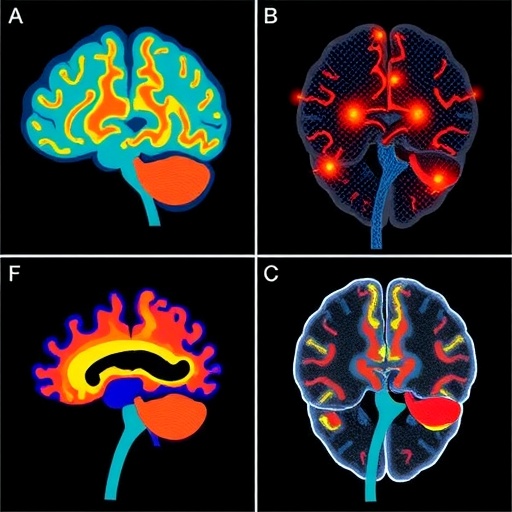In a groundbreaking new study published in npj Parkinson’s Disease, researchers Tang, Huang, Wang, and colleagues unveil a pioneering brain-clinical biotyping approach designed to deepen our understanding of idiopathic REM sleep behavior disorder (iRBD). This disorder, often a harbinger of neurodegenerative diseases such as Parkinson’s, presents a complex clinical puzzle. Through integrating advanced neuroimaging techniques with comprehensive clinical assessments, the team provides a detailed phenotypic breakdown that could reshape diagnostic and therapeutic strategies in neurology.
Idiopathic REM sleep behavior disorder manifests predominantly with vivid dream enactment behaviors during the rapid eye movement phase of sleep. Unlike other parasomnias, iRBD is increasingly recognized not merely as a sleep disorder but as a prodromal stage of synucleinopathies — a family of neurodegenerative diseases characterized by abnormal alpha-synuclein protein deposits. Despite this link, the heterogeneity in clinical presentations and disease progression rates has long impeded early, precise identification and stratification of patients at highest risk for converting to overt neurodegenerative syndromes.
Tang et al.’s study tackles this challenge by applying a multi-dimensional classification strategy, which they term brain-clinical biotyping. This method combines quantitative brain imaging data with detailed clinical symptomatology and neuropsychological profiles, aiming to identify distinct subtypes within the heterogenous iRBD population. The authors employ state-of-the-art magnetic resonance imaging (MRI) protocols, including volumetric and diffusion tensor imaging, to capture subtle abnormalities in regional brain structures involved in motor control, cognition, and sleep regulation.
A significant innovation lies in the study’s use of machine learning algorithms to analyze these vast, multi-modal datasets. By feeding the imaging biomarkers alongside clinical variables into unsupervised clustering models, the research team elucidates distinct patient clusters, each exhibiting unique patterns of brain alterations and symptom profiles. This nuanced stratification transcends traditional diagnostic categories, enhancing predictive accuracy for disease course and potential response to therapies.
The identification of discrete biotypes within iRBD patients carries profound implications. For example, one subgroup characterized by early brainstem degeneration and pronounced motor impairment markers may be at imminent risk of developing Parkinson’s disease within a short temporal window. Conversely, another cluster with predominant cognitive deficits and limbic system involvement might be predisposed to dementia with Lewy bodies, guiding clinicians toward more tailored monitoring and intervention strategies.
Furthermore, the study sheds light on the complex pathophysiological interplay underlying iRBD. The observed neuroanatomical changes implicate not only canonical regions such as the substantia nigra and locus coeruleus but also integrative networks linking cortical and subcortical structures. This broadens the existing paradigm, suggesting that iRBD’s progression is mediated by diffuse neurodegeneration, which mandates a systemic rather than localized therapeutic approach.
Crucially, the researchers incorporate longitudinal follow-up data to validate the prognostic utility of their biotyping. They demonstrate that these brain-clinical subtypes reliably predict differential rates of phenoconversion to overt synucleinopathies over a multi-year horizon. This predictive power is a significant step forward for the field, enabling earlier, mechanism-informed clinical decisions and enrollment in targeted clinical trials.
The technological sophistication driving the study is matched by meticulous clinical rigor. Participants underwent extensive neurobehavioral testing, polysomnography, and autonomic function assessments alongside imaging. This comprehensive profiling ensures that the identified biotypes reflect true pathobiological distinctions rather than artefacts of measurement or demographic variance, bolstering the study’s translational potential.
From a therapeutic standpoint, defining patient subgroups with more homogeneous disease mechanisms opens avenues for precision medicine in neurodegeneration. Clinical trials can be more efficiently designed by selecting participants based on their biotype, increasing the likelihood of detecting treatment effects that might be obscured in broadly defined, heterogeneous cohorts. Additionally, interventions might be personalized to target the dominant affected brain systems identified by imaging.
This research also signals a paradigm shift in approaching prodromal neurodegenerative disorders. By integrating neuroimaging and detailed clinical phenotyping with advanced analytics, it moves beyond symptom-based nosology toward biologically grounded classifications. Such precision paves the way for earlier identification and ultimately disease-modifying therapies when neural damage is still limited and potentially reversible.
The implications extend to public health realms as well. iRBD affects a sizable at-risk population, many of whom remain undiagnosed until motor or cognitive symptoms become overt. Enhanced biotyping strategies can underpin screening programs and inform counseling on prognosis and lifestyle modifications that may slow disease evolution or enhance quality of life.
While the results are compelling, the authors acknowledge several limitations. The cohort size, while substantial, warrants expansion to confirm generalizability across diverse populations and neuroimaging platforms. Future studies incorporating molecular biomarkers like cerebrospinal fluid alpha-synuclein and novel PET ligands could further refine subtype characterizations. Additionally, integrating genetic risk profiles may uncover genotype-phenotype interactions influencing disease trajectory.
In conclusion, the work by Tang et al. represents a tour de force in neurodegenerative research, harnessing cutting-edge brain imaging and clinical analytics to crack the complexity of idiopathic REM sleep behavior disorder. Their brain-clinical biotyping framework not only promises to revolutionize patient stratification and prognosis in iRBD but also sets a methodological benchmark for similar studies across neurodegenerative disease spectra. As science marches toward precision neurology, tools like these will be indispensable in transforming early diagnosis and catalyzing the development of effective, personalized treatment strategies.
This study is a clarion call for the neuroscience community to embrace integrated, data-driven approaches that respect the biological diversity inherent in complex disorders. With ongoing technological advances and collaborative research, the hope of mitigating the devastating impacts of Parkinson’s and related diseases appears more achievable than ever. Tang and colleagues have illuminated a path forward — one marked by scientific rigor, clinical relevance, and the promise of a future where neurodegeneration can be detected, characterized, and treated with unparalleled accuracy.
Subject of Research: Brain-clinical biotyping in patients with idiopathic REM sleep behavior disorder.
Article Title: Brain-clinical biotyping in patients with idiopathic REM sleep behavior disorder.
Article References: Tang, S., Huang, B., Wang, Y. et al. Brain-clinical biotyping in patients with idiopathic REM sleep behavior disorder. npj Parkinsons Dis. 11, 156 (2025). https://doi.org/10.1038/s41531-025-01012-0
Image Credits: AI Generated




